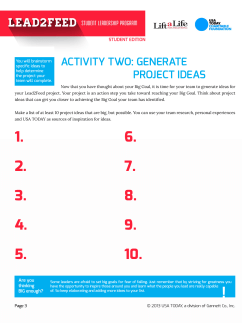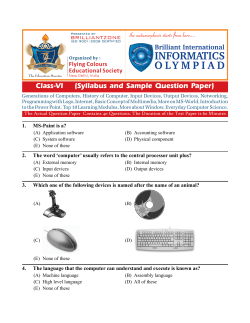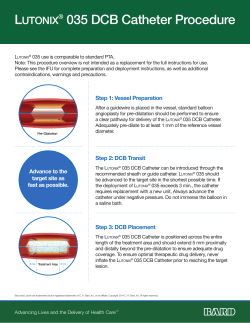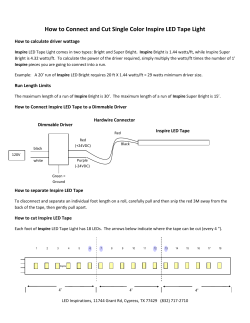
Mode I intralaminar crack-growth toughness of 90º layers of glass
Mode I intralaminar crack-growth toughness of 90º layers of glass fiberreinforced polymers Davi Montenegro1, Francesco Bernasconi, Markus Zogg1, Paolo Ermanni2, Rafael Libanori3, André Studart3 Madrid, April 8th, 2015 1Innovative Composite Structures, Inspire AG, Switzerland Department of Mechanical and Process Engineering, ETH Zurich, Switzerland 3Complex Materials, Department of Materials, ETH Zurich, Switzerland 2CMAS-Lab, Inspire ICS Davi Montenegro / April-8th-2015 / 1 Contents Introduction Quasi-static characterization DCB tests SENB tests Conclusions Inspire ICS Davi Montenegro / April-8th-2015 / 2 Introduction Characterization DCB SENB Conclusions Introduction – Motivation Fracture mechanics-based design of components requires determination of the fracture toughness FRPs Source: Adapted from Harris (2003) Fatigue in Composites, ch. 26., Woodhead Publishing Ltd. Inspire ICS Davi Montenegro / April-8th-2015 / 3 Introduction Characterization DCB SENB Conclusions Introduction – Literature Fracture toughness of FRPs is normally assessed by means of tests with double cantilever beam specimens + LEFM (linear-elastic fracture mechanics) concepts* Current standards restricted to 0º laminates (e.g. ISO 15024) Fiber direction Source: Manshadi et al. (2014) Comp. Part A 61, pp.43. *Laksimi et al. (1991) CST 41 / Sorensen and Jacobsen (1998) Comp. Part A 29 / Sun et al. (2006) Comp. Str. 15. Inspire ICS Davi Montenegro / April-8th-2015 / 4 Introduction Characterization DCB SENB Conclusions Introduction – Initial damage Initial damage in cross-ply laminates loaded under tension is mode I cracking in the 90º layers (transverse cracking)* Cross-ply σ σ 0º 90º 0º Cracks *Lim and Hong (1989) J. Comp. Mat. 23 / McCartney (1998) CST 58. Inspire ICS Davi Montenegro / April-8th-2015 / 5 Introduction Characterization DCB Conclusions SENB Introduction – Initial damage Transverse cracking is observed under quasi-static and fatigue loading* Quasi-static Tension/tension fatigue σ σ 0º 90º 0º . . . ... .. .. .. . . .. .. . . . .. ... . .. .. .. .. . . . . . .. . . . .. . . . .. .. . . . . . σ .. .. .. . . . . . .. . . . . .. . . . . . . . . . . .. .. .. . . . . . .. . . . . .. . . . . . . . . . . 0º 90º 0º . . . . . . ... .. .. .. . . .. .. . . . . .. .. .. . . .. .. . . . .. ... . .. .. .. .. . . .. .. .. . .. .. .. . . . . . . . . . *Berthelot and Le Corre (1999) Comp. Part B 30. Inspire ICS Davi Montenegro / April-8th-2015 / 6 σ . . . .. .. .. . .. . .. . . . . . .. . . .. . . .. .. .. . . . . . Characterization Introduction SENB DCB Conclusions Introduction Know-how gaps mode I fracture toughness of 90º FRP layers σ σ Driving force Crack-growth toughness (R-curve) (Not only crackinitiation*) Crack size NLEFM (nonlinear-elastic fracture mechanics) Source: Launey and Ritchie (2009) Adv. Mat. 21 *Canal et al. (2012) CST 72. Inspire ICS Davi Montenegro / April-8th-2015 / 7 Introduction Characterization DCB SENB Conclusions Introduction Goal To quantify the mode I crack-growth toughness of 90º GFRP layers taking into account inelastic effects Approach Quasi-static mechanical characterization Tests with DCB specimens Tests with SENB specimens + NLEFM Inspire ICS Davi Montenegro / April-8th-2015 / 8 Contents Introduction Quasi-static characterization DCB tests SENB tests Conclusions Inspire ICS Davi Montenegro / April-8th-2015 / 9 Introduction Characterization DCB SENB Conclusions Quasi-static characterization d 3-point-bending h Matrix (SikaDur300 [epoxy]): ISO 178 GFRP (E-glass + matrix): ISO 14125 Resin transfer molding L Cure: 2h @ 80ºC + 3h @ 125ºC; P = 2.5 bar Calculation of σ and ε accounted for large displacements 3FL σ= 2bh 2 Inspire ICS 2 d dh 1 6 3 + − 2 L L h d d d ε= 6 − 24.37 + 62.17 L L L L Davi Montenegro / April-8th-2015 / 10 3 5 Introduction Characterization DCB SENB Conclusions Quasi-static characterization Laminate is considerably more stiff and more brittle than the matrix, as usual Matrix presents considerable inelastic deformation Stress (MPa) 120 100 80 Matrix 60 Tg , matrix ≅ 80o C (DSC) 10.28 ± 0.75 GPa GFRP GFRP E2,= 90º = v 52.1 ± 1.1% 40 20 0 Ematrix = 3.26 ± 0.02 GPa f 0 2 4 6 8 Strain (%) Inspire ICS Davi Montenegro / April-8th-2015 / 11 Contents Introduction Quasi-static characterization DCB tests SENB tests Conclusions Inspire ICS Davi Montenegro / April-8th-2015 / 12 Introduction Characterization DCB SENB Conclusions DCB tests Hinges with a0 = 50 mm and a0 = 30 mm Aluminum substrate* Test speed: 0.05 mm/min 160 x 20 x 4 mm3 Fibers Hinge Adhesive layer *Reeder et al. (2004) Comp. Part A 35. Inspire ICS Davi Montenegro / April-8th-2015 / 13 Characterization Introduction DCB SENB Conclusions DCB tests Specimens showed early failure probably due to excessive bending stresses in the cantilever arms New attempt with smaller initial crack length was also not successful Force (N) 20 Hinge 30mm away from crack tip Early failure Tip of the initial crack 10 Hinge 50mm away from crack tip 0 95mm 4 mm 0 5 10 Displacement (mm) Inspire ICS Davi Montenegro / April-8th-2015 / 14 Introduction Characterization DCB SENB Conclusions DCB tests • Aluminum substrates (thickness: 1mm) were glued onto the surfaces of the specimens as a means to further stiffen them early failure was avoided, however the cracks were deflected Crack deflection Crack deflection Force (N) 30 Aluminum substrates 20 10 0 Inspire ICS Delamination substrate-specimen 0 5 10 15 Displacement (mm) Tip of the initial crack Davi Montenegro / April-8th-2015 / 15 4 mm Introduction Characterization DCB SENB Conclusions DCB tests Crack deflection probably caused by tensile stresses in the x-direction of the specimen around the crack tip y x Ideal situation: specimen configuration where the stresses acting in the desired crack propagation direction are minimized single edge-notched beam (SENB) Inspire ICS Davi Montenegro / April-8th-2015 / 16 Contents Introduction Quasi-static characterization DCB tests SENB tests Conclusions Inspire ICS Davi Montenegro / April-8th-2015 / 17 Introduction Characterization DCB SENB Conclusions SENB tests ASTM E1820 test method for measuring the fracture toughness JIC and R-curves of metallic materials J is the nonlinear strain-energy release rate J = G under linear-elastic conditions * Method was used before for heterogeneous materials* *Source: Ritchie (2011), Nature Materials 10, DOI: 10.1038/NMAT3115 Inspire ICS Davi Montenegro / April-8th-2015 / 18 Introduction Characterization SENB DCB Conclusions SENB tests Compliance method Specimens: 30 x 5 x 2.5 mm3 Load cycles with small displacement increments: stable crack propagation Matrix GFRP 90o Matrix Force (N) 40 30 20 10 0 0.0 GFRP 90º 0.1 0.2 0.3 LLD (mm) 0.4 LLD: Load-line displacement Inspire ICS Davi Montenegro / April-8th-2015 / 19 Introduction Characterization DCB SENB Conclusions SENB tests Compliance method Compliance ‘C’ used to calculate crack length ‘a’ a = 0.997 − 3.58U − 1.51U 2 − 110U 3 + 1232U 4 − 4400U 5 W = U ( ) FC + 1 −1 Calibration factor ‘F’ with initial crack length* *Launey et al. (2010) Acta Biomaterialia 6, pp.1505 Inspire ICS Davi Montenegro / April-8th-2015 / 20 Introduction Characterization SENB DCB Conclusions SENB tests Data reduction Strain-energy = J J el + J in release rate = J Fitting Effective stress K= IR 1.9 Apl K I2 + E ' b (W − a ) J= C1( ∆a + δ ) C2 K= IR , C J ⋅ E ' intensity factor J IC ⋅ E ' Critical effective J in = β 100 ⋅ J ∆acorr Inspire ICS Davi Montenegro / April-8th-2015 / 21 stress intensity factor Contribution of inelastic part Introduction Characterization SENB DCB Conclusions SENB tests 0.4 0.3 0.2 0.1 0.0 0 200 400 600 800 2.5 2.0 1.5 1.0 0.5 0.0 0 100 200 300 400 500 600 700 Crack extension (µm) KIR (MPa.m1/2) J-integral (kJ/m2) Results 3.0 2.5 2.0 1.5 1.0 0.5 0.0 0 100 200 300 400 500 600 700 Crack extension (µm) Laminate is much less tough than the matrix; higher difference in J than KIR because of the difference in the elastic moduli Resistance to damage propagation rises in the range of crack extensions obtained Inspire ICS Davi Montenegro / April-8th-2015 / 22 Introduction Characterization SENB DCB Conclusions SENB tests Results JIC values obtained according to ASTM E1820 JIC [kJ.m-2] KIR,C [MPa.m1/2] This work Canal et al.* E-glass/ MTM-57 2.15 E-glass/ SikaDur300 2.0 1.5 1.42 F 1.27 F Fmax 1.0 d d 0.5 0.0 K IR ,C = J IC E ' 0.18 Matrix Matrix GFRP90º GFRP 1.27MPa m *Canal et al. (2012) CST 72. Inspire ICS Davi Montenegro / April-8th-2015 / 23 K Ic = f ( Fmax ) 1.8MPa m Characterization Introduction DCB SENB Conclusions SENB tests Inelastic contribution to the total crack-driving force accounted for up to 73% in the GFRP and 38% in the matrix β = Jin / J (%) 80 60 40 20 0 0 Inspire ICS 200 400 600 Crack extension (µm) Davi Montenegro / April-8th-2015 / 24 Contents Introduction Quasi-static characterization DCB tests SENB tests Conclusions Inspire ICS Davi Montenegro / April-8th-2015 / 25 Introduction Characterization DCB SENB Conclusions Conclusions The DCB specimen was not suited for assessing the mode I fracture toughness of 90º GFRP layers The mode I intralaminar crack-growth toughness of 90º GFRP layers was successfully quantified with SENB specimens and concepts of NLEFM The method allows to determine full crack-resistance curves (thus not only a value of fracture toughness at the onset of crack propagation) Inspire ICS Davi Montenegro / April-8th-2015 / 26 Introduction Characterization DCB SENB Conclusions Conclusions R-curves were obtained for a commercial epoxy resin and for 90º GFRP lamina The contribution of the inelastic part Jin to the total crackdriving force J to the accounted for up to 73% in the GFRP during crack propagation Inspire ICS Davi Montenegro / April-8th-2015 / 27 Thank you for your attention! Q&A Davi Melo Montenegro Innovative Composite Structures, ICS Inspire AG Technoparkstr. 1 PFA H23 CH-8005 Zürich Switzerland +41 44 632 73 67 davi.montenegro@inspire.ethz.ch Inspire ICS Davi Montenegro / April-8th-2015 / 28 Dr. Markus Zogg Team Leader ICS Inspire AG Technoparkstr. 1 PFA H21 CH-8005 Zürich Switzerland +41 44 632 33 79 zogg@inspire.ethz.ch References [1] M. Shokrieh and M. Heidari-Rarani, "Effect of stacking sequence on R-curve behavior of glass/epoxy DCB laminates with 0º//0º crack interface," Materials Science and Engineering A, vol. 529, pp. 265-269, 2011. [2] B. Sorensen and T. Jacobsen, "Large-scale bridging in composites: R-curves and bridging laws," Composites: Part A, vol. 29, pp. 1443-1451, 1998. [3] A. Laksimi and others, "Mode I interlaminar fracture of symmetrical cross-ply laminates," Composites Science and Technology, vol. 41, pp. 147-164, 1991. [4] X. Gong, A. Hurez and G. Verchery, "On the determination of delamination toughness by using multidirectional DCB specimens," Polymer Testing, vol. 29, pp. 658-686, 2010. [5] ISO, 15024 - Fibre-reinforced plastic composites -- Determination of mode I interlaminar fracture toughness, [6] GIC, for unidirectionally reinforced materials, 2001. H. Chai, "The characterization of Mode I delamination failure in non-woven, multidirectional laminates," Composites, vol. 15, pp. 277-290, 1984. Inspire ICS Davi Montenegro / April-8th-2015 / 29 References [7] X. Sun, M. Wood and L. Tong, "A parametric study on the design of stitched laminated DCB specimens," Composite Structures, vol. 75, pp. 72-78, 2006. [8] M. Heidari-Rarani, M. Shokrieh and P. Camanho, " Finite element modeling of mode I delamination growth in laminated DCB specimens with R-curve effects," Composites Part B, vol. 45, pp. 897-903, 2012. [9] B. Manshadi et al, "An interative analytical/experimental study of bridging in delamination of the double cantilever beam specimen," Composites: Part A, vol. 61, pp. 43-50, 2014. [10] J.-M. Berthelot et al, "Transverse cracking of cross-ply laminates: Part 1. Analysis.," Composites Part A, no. 27A, pp. 989-1001, 1996. [11] J.-M. Berthelot and J.-F. Le Corre, "Modelling the transverse cracking in cross-ply laminates: application to fatigue," Composites: Part B, vol. 30, pp. 569-577, 1999. [12] L. Canal, C. González, J. Segurado and J. Llorca, "Intraply fracture of fiber-reinforced composites: Microscopic mechanisms and modeling," Composites Science and Technology, vol. 72, pp. 1223-1232, 2012. [13] J. Reeder, K. Demarco and K. Whitley, "The use of doubler reinforcement in delamination toughness testing," Composites: Part A, vol. 35, pp. 1337-1344, 2004. Inspire ICS Davi Montenegro / April-8th-2015 / 30 References [14] K. Koester, J. Ager III and R. Ritchie, "The true toughness of human cortical bone measured with realistically short cracks," Nature Materials, vol. 7, no. August, pp. 672-677, 2008. [15] F. Barthelat and H. Espinosa, "An experimental investigation of deformation and fracture of nacre-mother of pearl," Experimental mechanics, vol. 47, pp. 311-324, 2007. [16] M. Launey et al., "Mechanistic aspects of the fracture toughness of elk antler bone," Acta Biomaterialia, vol. 6, pp. 1505-1514, 2010. Inspire ICS Davi Montenegro / April-8th-2015 / 31
© Copyright 2025









